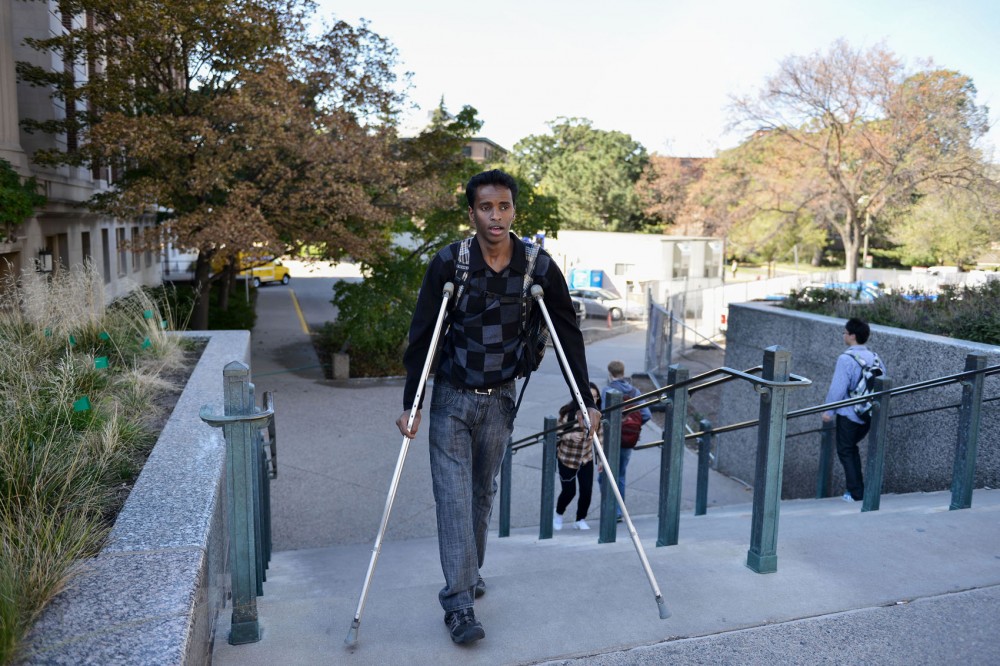Light-rail construction has created new frustrations for every student on the University of Minnesota’s Twin Cities campus.
But for students with disabilities, closed sidewalks, fewer bus stops and makeshift walkways can present an additional challenge.
“People that went to the [University] years back before the light rail — I feel like they were in a dream school,” said Abdirahman Hassan, a sophomore genetics major and member of the University’s Disabled Student Cultural Center.
For students like Hassan and Jacob Vasquez, a child psychology junior who is blind, construction can make getting around campus more difficult.
Vasquez, who is also in DSCC, said if he needs assistance, he will either ask for help or call the University’s Paratransit Services.
Though DSCC hasn’t brought up the construction issue yet this year, Vasquez said it’s something he thinks they will work on.
Three main concerns about light-rail construction were raised last year by DSCC members, said Chad McGuire, a former DSCC member and a master’s student in urban and regional planning.
Changes to bus routes, signage and physical barriers were all equally important to group members, he said, but had specific importance to students depending on their circumstances.
Students who use wheelchairs may be more concerned about physical barriers, he said, while students with low vision may find changing bus routes more problematic.
Israr Khan, a chemistry senior and DSCC co-chair, said fewer bus stops remain a concern both for him and other students.
Many Campus Connector stops are far away from classroom buildings and it takes longer for students to get to class, he said.
Hassan agreed. Because of construction outside Coffman Union he said he has to walk from Eddy Hall on the East Bank or Willey Hall on the West Bank to get to his class in the Science Teaching and Student Services building if he’s getting to campus by bus.
“Either one is difficult,” he said.
People in the University community have asked for a bus stop near Coffman Union, said Jacqueline Brudlos, a spokeswoman for the University’s Parking and Transportation Services.
“The reality is that that stretch of road is so congested,” she said. “There’s so many pedestrians and bicyclists and cars it was deemed not safe for a bus stop.”
Light-rail construction is contracted by the Metropolitan Council. According to Casper Hill, a City of Minneapolis spokesman, contractors are required to put up walkways that are 48 inches wide, with places every 200 feet where two wheelchairs — or other wheeled vehicles, like strollers — can pass each other.
For walkways that connect curbs without ramps, Hill said, contractors are required to install ramps that meet Americans with Disabilities Act guidelines.
Contractors are charged fees for occupying traffic lanes, so the city checks construction areas daily to see that they meet city guidelines, Hill said.
At the University, accessibility of light-rail construction sites is checked weekly, said Roberta Juarez, physical access coordinator for the University’s Disability Services.
“We walk the sites together and if something needs to be corrected, it is pointed out and it is corrected as quickly as possible,” she said.
The construction and design teams have also made an effort to minimize disruption, Juarez said, adding that the accessibility of light-rail construction areas has gotten better over time.
Accessibility across campus
The University’s Office of Disability Services has made an ongoing effort to improve accessibility across campus.
A number of campus buildings were constructed before the 1990 passage of the Americans with Disabilities Act and may require updates to meet its guidelines.
Vasquez said he had difficulty accessing a class in the basement of Ferguson Hall because doors were not labeled in Braille.
“This was after they just completed a paint job,” he said. “They should’ve added the signs soon after.”
Two recycling bins near the classroom entrance helped Vasquez to navigate, he said, but had the door been located in the middle of a hallway, it would’ve been more difficult.
Nolte Center for Continuing Education and Scott Hall — both located on the East Bank — have planned elevator installations, Juarez said. Both installations are planned to be completed in January 2014.
During design and construction of campus buildings and renovations, Juarez said she reviews plans for disability-related access and modifications.
“We are becoming more and more accessible as time goes on,” she said.


